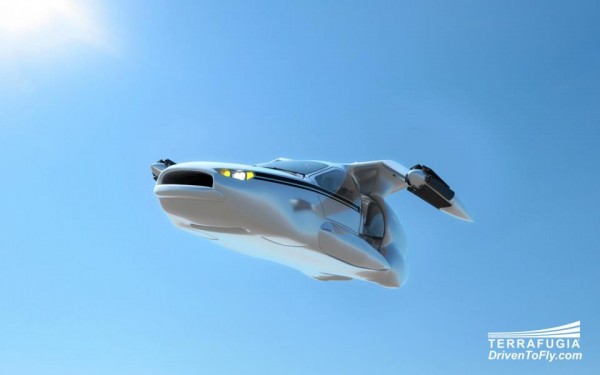Flying cars are the dreams of science fiction, right? Even ones which would have some type of cleaner electric propulsion system? Perhaps not, if a start up founded by MIT graduates has anything to say about it.
Terrafugia, according to Xconomy, is currently conceptualizing the TF-X Vision, its second idea for a flying car. The first, known as the Transition, “was designed for private pilots to be able to land on an airport runway, fold up the wings in less than a minute, and drive right out onto public roads.” It is still under development – no big surprise there – but has already seen some prototype flights as well as a sold a number of pre-orders adding up to millions in sales.
The TF-X Vision, meanwhile, is seen as the next evolution of what Terrafugia believes will be a new form of personal transportation for tomorrow. It takes on the shape of a four-seat, vertical takeoff and landing plug-in hybrid-electric flying car that would make use of cutting edge technologies to help one commute home safely either aloft in the skies or down to earth on local roads, including being self-flying as necessary.

Described as “a fixed wing street-legal aircraft with electric ground drive and electric power assist on takeoff and landing,” according to Terrafugia, the TF-X Vision would have a theoretical flight range of at least 500 miles. No maximum range is given for driving however. In terms of what’s under the hood, twin 600 hp electric motor pods, with 16 separate motors per pod, generate what’s said to a a megawatt of power to lift one up. From there the electric motors, in true hybrid fashion, tie into a 300 hp gas engine to help this aircraft travel up to 200 miles per hour.
Key features would include being automatically capable of avoiding other air traffic, bad weather, and restricted and tower-controlled airspace; having a backup full-vehicle parachute system which can be activated by the operator in an emergency; automatically implementing an emergency auto-land at the nearest airport if the driver becomes incapacitated; being able to takeoff vertically from a level clearing of at least 100ft in diameter and fitting nto a standard construction single car garage when you get back from your work day or weekend vacation.
“This is the right time for us to begin thinking about the future of the company beyond Transition development,” said Terrafugia CEO/CTO Carl Dietrich in a statement. “We are passionate about continuing to lead the creation of a flying car industry and are dedicating resources to lay the foundations for our vision of personal transportation.”
Now if the TF-X Vision sounds like something you are ready to plunk down a deposit on, first consider these fair warnings from Terrafugia:
- Final pricing is not set yet and, given that cost of production is the highest part of what you’ll be paying, one can expect it not to be cheap. It would likely line up with very high-end luxury cars of today.
- Development is expected to take close to a decade, if not longer. The Transition first will likely have to be successful enough to prove the idea the public is ready for this type of vehicle.
- And then there’s the Federal Aviation Administration – it is said to have shown “willingness to consider innovative technologies and regulatory solutions that are in the public interest and enhance the level of safety of personal aviation,” but this doesn’t mean by any stretch it has signed off yet on Jetsons style transportation.
An alternative to short haul flights on commercial airlines which could be more environmentally friendly? Or just more traffic on the streets (and now skies) causing its own forms of pollution? It is too early to say at this point, but maybe as the technology evolves over the coming years, more green options will emerge to make it even more eco-focused.